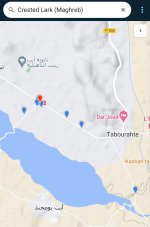Nick
It was a very short focused trip.
5 June 2023
Merja Zerga - 2 Marsh Owl (in addition to a few other bits)
Lac de Sidi Boughaba - Maghreb Owl found by day plus 10 Marbled Duck, 40 White-headed Duck & 40 Crested Coot
6 June 2023
Ifrane area - 5 Atlas Wheatear, 10 Atlas Flycatcher, 2 Moussier's Redstart & 3 Levaillant's Woodpecker plus 8 Eleonora's Falcons
7 June 2023
Travelling - 20 Atlas Wheatear & Lanner
Imiter- Pharoah Eagle Owl (adult & two well grown chicks), 3 Mourning Wheatear (male, female & fledged young) & Lanner
8 June 2023
Tagdilt Tip - 10 Thick-billed Lark, 10 Temminck's Lark & 6 Red-rumped Wheatear
Travelling - 2 Blue-cheeked Bee-eater
Tabourahte - the above long-billed Crested Lark population (randonii?) & Rufous Bushchat
So 3.5 days birding - 5 ticks - Marsh, Maghreb & Pharoah Eagle Owls, Atlas Wheatear & Atlas Flycatcher amongst 131 species
This leaves me Andalusian Hemipode in Morocco & other targets in Western Sahara & Mauretania.
Pics will appear on my World Photo Yearlist thread in due course but I need to finish identifying a bunch of moths from last night's field moth trapping and my Ontario & Michigan pics first and I also have a short Majorca trip planned next week:-
Well, let's see how long I can keep on top of this... :) 1. Northern Shoveler 2. Gadwall 3. Eurasian Wigeon 4. Mallard 5. Northern Pintail 6. Goosander 7. Pied Avocet 8. Grey Plover 9. Eurasian Curlew 10. Ruddy Turnstone 11. Dunlin 12. Common Snipe 13. Little Egret 14. Barn Owl 15. Merlin 16...

www.birdforum.net
No rest for the wicked. 😀
All the best
Paul






